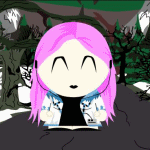Last week, I tried to write a post about the second season of “Torchwood” (and one day I will write something about the series – hopefully). But this is not a post about “Torchwood,” it’s a post about “Torchlight.” And those two have little to nothing in common.
“Torchlight” is not just the name of a computer game, but also of the town that serves as a base of operation. And what kind of operation? The monster-slaying kind.
“Torchlight” is a hack’n’slay role-playing game. To those of you not familiar with RPGs or hack’n’slay, a little explanation: role-playing games come in two varieties, mainly. There’s the big epic ones with a huge story, packed with emotions, interesting characters and unexpected turns. Then there’s the not-quite-so-epic ones. The ones in which the story hardly matters. Those are the hack’n’slay kind. You just move through the levels and kill everything that moves (and if it doesn’t move? Doesn’t matter, hack it to pieces anyway). The only things you’re interested in a game of that kind are levelling up and hoarding treasures (which means finding lots of great weapons and armour and making lots of money with the rest of the equipment).
The game “Torchlight” reminds me of the best of those games: “Diablo.” I already mentioned that game in my post about “Ultima” yesterday. So I’ll use the chance to give you a bit of background information about the whole RPG-issue.
The story actually begins long before computer games, in the late 70ies. That is the time in which the first RPGs were created. They were ‘pen and paper,’ meant to be played with a group of people, sitting around a table with one being the game master (who creates the whole adventure and acts as every character that’s not played by the others). Even though many players probably were mostly interested in levelling up and finding great weapons and armour then as well, the game master usually put a lot of time and life blood into the creation of every adventure and created – or at least tried to create – epics of his own.
When the first RPGs were created for the computer, those people were the target group. They knew the systems, they had played hundreds and hundreds of hours and knew all the rules. When they sat down in front of a computer – because there was no group available, for instance –, they wanted to get the same kind of feeling out of their new game. So the great series of RPGs created at that time were either based on a ‘pen and paper’ system or at least mimicking the basic principles: epic story and group to act with. Games with just one hero were rare.
When computer games became more complex – and, because of this, more expensive –, some genres fare worse than others. During the early 90ies, other types of games became popular, most of all the ego shooters. It seemed as if the role-playing games were doomed to die. Then “Diablo” came.
Two factors were making the game so popular. First of all it was a multiplayer game. People could connect their computers (on LAN parties, for example, but also over the internet) and fight the hordes of monsters together. In addition, the levels were not pre-created, they were randomized every time a player started a new game, build of various parts that could be connected in various ways. Those two factors together made the game popular – and not just with role-playing veterans. Many people who were more action oriented started to play the game. It was easy to learn, but hard to master. And, in turn, producing a role-playing game became more popular with the publishers and software companies again.
And “Torchlight?” There’s hardly any story worth mentioning – but I don’t care. Usually I play RPGs to see (and play) a good story. In this case, though, the monster slaying is fun enough on its own, so I don’t miss the story.
To me, the game is a combination of the good old principles of the first “Diablo” and a very nice comic-like design. The three characters and the surroundings have a little steampunk charm (there’s a robotic bard in the city, for instance). The mage is an alchemist, the barbarian is a destroyer, the huntress is a vanquisher. They look slightly different (the alchemist, for instance, wears goggles on his helmet) and so does the place. And there’s one new invention I really love: the pet.
When you create a character, you also choose between a dog or a cat (well, the cat looks like a small sabre-tooth tiger without sabre-teeth). This pet follows you, fights with you and can be change by feeding it with fish (which you can catch in fishing holes in the various levels). But the most important – and useful – feature of the pet is this: you can put all the stuff you have gathered and want to sell into your pet’s own (!) inventory and sent it back to town alone (!) to sell it. Thirty seconds to a minute or so later, the pet will appear again with the money for the stuff. That’s what I really call a good pet!
As the limits of the inventory are the main problem for most hack’n’slay games, this new idea really comes in handy. There’s also the good old “Scroll of the Town Portal,” of course, but sending the pet back is faster and more fun.
“Torchlight” is fun, easy enough to learn and challenging enough to stay with it. There’s big hordes of monsters to slay and big heaps of stuff to find. There’s no story, but I promise you won’t miss it.





No comments:
Post a Comment